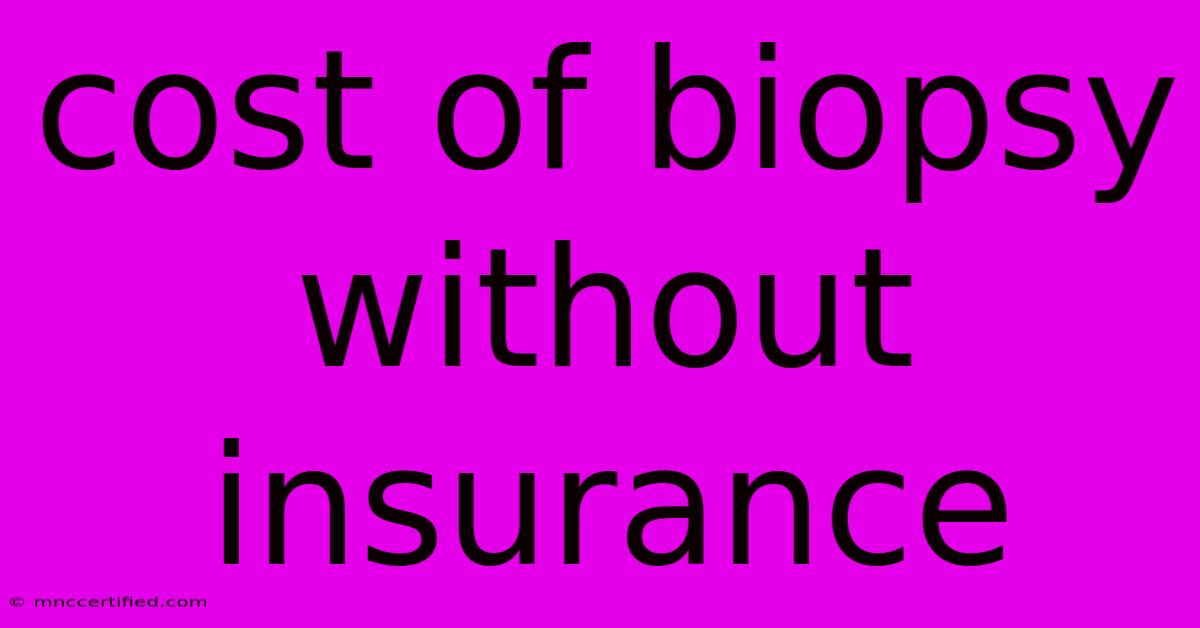Cost Of Biopsy Without Insurance

Table of Contents
The Cost of a Biopsy Without Insurance: A Comprehensive Guide
Facing a potential health issue and needing a biopsy can be stressful, especially when insurance isn't an option. Understanding the potential costs beforehand can help alleviate some anxiety and allow for better financial planning. This guide explores the various factors influencing the cost of a biopsy without insurance and offers strategies for managing the expense.
Factors Affecting the Cost of a Biopsy Without Insurance
The price of a biopsy without insurance varies significantly depending on several key factors:
1. Type of Biopsy
Different biopsy types involve different procedures and levels of complexity, directly impacting the cost. For instance:
- Needle Biopsy: This minimally invasive procedure, often used for breast, liver, or kidney biopsies, generally costs less than more invasive options.
- Incisional Biopsy: This involves removing a small portion of the suspicious tissue. The cost increases with the size and location of the tissue sample.
- Excisional Biopsy: This removes the entire abnormal growth. It's generally the most expensive biopsy type because it's more extensive.
- Bone Marrow Biopsy: This procedure, often used for diagnosing blood disorders, is highly specialized and typically more expensive than other types of biopsies.
2. Location of the Biopsy
Geographic location plays a crucial role in pricing. Costs in major metropolitan areas are often higher than in rural settings due to higher overhead and specialist fees. The specific facility – a hospital, outpatient surgical center, or doctor's office – will also influence the final bill.
3. Anesthesia Requirements
Some biopsies require anesthesia, significantly increasing the overall cost. The type of anesthesia (local, regional, or general) and the duration of the procedure will impact the total expense.
4. Pathologist Fees
Once the tissue sample is obtained, a pathologist analyzes it. Their fees are separate from the procedure itself and add to the total cost. The complexity of the analysis can also influence the pathologist's charges.
5. Additional Tests and Procedures
Often, biopsies are followed by additional tests to analyze the sample, such as laboratory tests or imaging studies. These additional procedures further increase the overall expenses.
Estimating the Cost: A Range of Possibilities
Without insurance, the cost of a biopsy can range from a few hundred dollars for a simple needle biopsy to several thousand dollars for a more complex excisional biopsy requiring general anesthesia and extensive pathological analysis. It's crucial to contact the healthcare provider directly to get an accurate estimate before the procedure. Ask for a detailed breakdown of all charges, including:
- Physician's fees: The doctor performing the biopsy.
- Facility fees: The cost of using the hospital or surgical center.
- Anesthesia fees: If applicable.
- Pathology fees: The cost of tissue analysis.
- Other charges: Any additional tests or medications.
Strategies for Managing the Cost
Managing the cost of a biopsy without insurance requires proactive planning. Consider these options:
- Negotiate with the provider: Many healthcare providers are willing to negotiate prices, especially for patients paying out-of-pocket. Ask about payment plans or discounts.
- Shop around: Compare prices from different facilities and physicians in your area.
- Consider a medical credit card: These cards can help finance medical expenses, but be aware of the interest rates.
- Explore financial assistance programs: Some hospitals and healthcare providers offer financial assistance programs for low-income patients. Check with the facility directly.
- Crowdfunding: Online platforms allow you to seek financial support from friends, family, and the wider community.
Conclusion: Planning Ahead is Key
Facing a biopsy without insurance necessitates careful planning and preparation. Understanding the factors that influence the cost, obtaining accurate estimates, and exploring available payment options can significantly alleviate financial stress during a challenging time. Remember, proactive communication with your healthcare provider is crucial in navigating this process effectively.

Thank you for visiting our website wich cover about Cost Of Biopsy Without Insurance. We hope the information provided has been useful to you. Feel free to contact us if you have any questions or need further assistance. See you next time and dont miss to bookmark.
Featured Posts
-
Suits La Cast Shake Up Revealed
Nov 21, 2024
-
Tow Truck Insurance Requirements
Nov 21, 2024
-
Is Lipiflow Covered By Insurance
Nov 21, 2024
-
Delve Insight Us Leads Pancreatic Cancer
Nov 21, 2024
-
Arlington Heights Auto Insurance
Nov 21, 2024